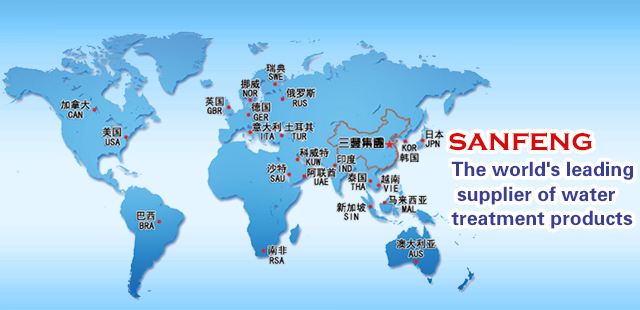This standard is applicable to industrial sulfuric acid and bauxite (or aluminum hydroxide) as the raw material of aluminum sulfate, used as a drinking water purifier.
Molecular formula: AI2 (SO4) 3 • xH2O.
Molecular weight: 342.14 (according to the 1979 international atomic weight. In anhydrous aluminum sulfate).
1 technical requirements
1.1 appearance
This product is a block or flake, block size is not more than 15 mm.
1.2 project and indicators
Project indicators
Alumina (AI2O3), % 15.6 or higher
Other metal oxide (with Fe2O3), % 1.0 or less
Free acid conforms to the test
Water insolubles, % 0.15 or less
Arsenic (As), % 0.0005 or less
Heavy metals (Pb), % 0.002 or less
2. The test method
Except where noted, test reagents used for analysis reagent, water for distilled water or purified water, corresponding solution for aqueous solution.
2.1 alumina and other metal oxide content determination
2.1.1 principle
Join excessive ethylenediamine tetraacetic acid disodium salt solution and boil, made with aluminum and other metal ions complexation, with xylenol orange as the indicator, use a lead nitrate solution titration of excessive ethylenediamine tetraacetic acid disodium, and boil, then add the potassium fluoride solution resolve with aluminum complex ethylenediamine tetraacetic acid disodium, reoccupy lead nitrate solution titration.
2.1.2 equipment
General laboratory instruments and equipment.
2.1.3 reagent and solution
2.1.3.1 ethylenediamine tetraacetic acid disodium (GB 1401-78) : 0.04 M standard solution. According to 14.9 g the reagents, with a moderate amount of water to dissolve, into 1000 ml volumetric flask, dilute to scale, blending.
2.1.3.2 ammonia (GB 631-77) : 1:1 solution.
2.1.3.3 hydrochloride (GB 622-77) : 1:1 solution.
2.1.3.4 - acetic acid sodium acetate buffer solution (GB 676-78, GB 693-77) : PH 5 ~ 6, said take 200 g sodium acetate, soluble in water, and 30 ml ice acetic acid, diluted to 1000 ml.
2.1.3.5 xylenol orange: indicator, 0.5% solution.
2.1.3.6 chrome black T (3086-59 HGB) : indicator, according to GB 603-603 preparation preparation methods and product configuration.
2.1.3.7 ammonia - ammonium chloride buffer solution armor (GB 631-77, GB 77-631) : the pH value is about 10, according to GB 603-603.
2.1.3.8 lead nitrate (HG - 1070-77) : 0.04 M standard solution. According to 13.25 g lead nitrate, soluble in water, add 3 ml ice acetic acid, diluted to 1000 ml.
2.1.3.8.1 ethylenediamine tetraacetic acid disodium standard solution of lead nitrate standard solution ratio (volume ratio) measurement:
Move to take 25 ml ethylenediamine tetraacetic acid disodium standard solution [2.1.3.1]. Put in 500 ml conical flask, add 15 ml with b - sodium acetate buffer solution (2.1.3.4). With 60 ml water, add 3 ~ 4 drops xylenol orange indicator [2.1.3.5]. With [2.1.3.8] lead nitrate standard solution titration to orange, is the end.
2.1.3.8.2 calculation
The ratio of K press type calculation:
K = 25 / V (1)
Type: V - titration is consumed when the volume of lead nitrate standard solution, mL.
2.1.3.9 zinc oxide (GB 1260-77) : 0.04 M standard solution. Said take 3.2552 g (called a quasi to 0.0002 g) via 800 oc burning to constant weight benchmark zinc oxide, put in a beaker, [2.1.3.3] with 40 ml of hydrochloric acid solution, heat to dissolve. After cooling into 1000 ml volumetric flask, dilute to scale, blending.
2.1.3.9.1 ethylenediamine tetraacetic acid disodium standard solution calibration
Move 25 ml zinc oxide solution [2.1.3.9], put in 500 ml conical flask, add 65 ml water, ammonia neutralization to pH7 ~ 8 [2.1.3.2], add 10 ml of ammonia - ammonium chloride buffer solution [2.1.3.7], 5 drops chrome black T indicator [2.1.3.6], with ethylenediamine tetraacetic acid disodium [2.1.3.1] standard solution titration to the pure blue.
2.1.3.9.2 calculation
The molar concentration of ethylenediamine tetraacetic acid disodium M press type calculation:
M = 25 m1 / V (2)
Type: when V - titration by ethylenediamine tetraacetic acid disodium the volume of standard solution, mL;
M1 - zinc oxide the molar concentration of standard solution.
2.1.3.10 potassium fluoride (GB 1271-77) : 10% solution.
2.1.4 measurement procedures
According to take 10 g (called a quasi to 0.001 g) sample, put in a beaker, add 80 ml water heating dissolved, after cooling out into a 500 ml volumetric flask and diluted to scale, shake, let stand for a moment, immediately move to take 20 ml to 500 ml conical flask, move take 50 ml ethylenediamine tetraacetic acid disodium standard solution [2.1.3.1], add 25 ml of water, boil 3
Minutes, add 3 ~ 4 drops after cooling xylenol orange indicator [2.1.3.5], with ammonia [2.1.3.2] or [2.1.3.3] hydrochloric acid solution to orange, add 10 ml - acetic acid sodium acetate buffer solution [2.1.3.4], [2.1.3.8] in lead nitrate standard solution titration to changed from yellow to orange is the end point. Write down the consumed volume (V1), add 15 ml potassium fluoride solution 2.1.3.10 boil for 5 minutes, reoccupy after cooling [2.1.3.8] lead nitrate standard solution titration to the finish line, write down the volume of consumed (V2).
2.1.5 representation and calculation results.
2.1.5.1 alumina (AI2O3) the percentage of the X1 press type calculation:
X1 = 0.05098 V2KM / 20 g / 500 x 100 (3)
Type: V2 - the second volume consumption of lead nitrate standard solution titration, mL;
K - ethylenediamine tetraacetic acid disodium standard solution for the ratio of lead nitrate standard solution;
M - ethylenediamine tetraacetic acid disodium the molar concentration of standard solution;
G - referred to in the sample weight, G;
0.05098 - every millimoles ethylenediamine tetraacetic acid disodium is equivalent to the amount of AI2O3, g;
The difference between the two parallel determination results is not greater than 0.1%.
2.1.5.2 with Fe2O3 of thousands of other metal oxide percentage X2 press type calculation:
X2 = 0.07985 M (50 - V1K - V2K) / 20 g / 500 x 100 (4)
Type: V1 - the first volume of consumption lead nitrate standard solution titration, mL;
K - with [2.1.5.1];
M - with [2.1.5.1];
G -- with [2.1.5.1];
0.07985 - every millimoles ethylenediamine tetraacetic acid disodium is equivalent to the amount of Fe2O3, g.
2.2 the determination of free acid content
2.2.1 principle
With phenolphthalein as indicator, with the potassium hydroxide free acid in standard solution titration test solution.
2.2.2 equipment
General laboratory instruments and equipment.
2.2.3 reagent and solution
2.2.3.1 potassium hydroxide (GB 2306-80) : 0.2 N standard solution, according to GB 601-601 "standard solution preparation method of preparation and calibration.
2.2.3.2 sulfate (GB 625-77) : 0.2 N solution.
2.2.3.3 phenolphthalein (HGB 3039-59) : indicator, 1% ethanol solution, according to GB 603-603, with potassium hydroxide solution [2.2.3.1] and to pale pink.
2.2.3.4 potassium fluoride (GB 1271-77) : about 50% of the solution, according to take 500 g potassium fluoride, add 200 ml contains no dissolved carbon dioxide water, use do not contain carbon dioxide water diluted to 1000 ml. Add 2 ml phenolphthalein indicator [2.2.3.3], with a saturated solution of potassium hydroxide or sulfuric acid to reddish, filter the insolubles (don't washing), storage in plastic bottles.
2.2.4 measurement procedures
According to take 10 g (called a quasi to 0.01 g) sample, put in a beaker, add right amount water, heat to dissolve, after cooling out into a 500 ml volumetric flask and diluted to scale, blending. Move in 25 ml to 250 ml conical flask, [2.2.3.2] take 10 ml of sulphuric acid solution, add 5 ml of potassium fluoride solution [2.2.3.4] and 4
Drops of phenolphthalein indicator [2.2.3.3], [2.2.3.1] with potassium hydroxide standard solution titration to pink (30 seconds not faded) to the finish. At the same time do the blank test with 25 ml water.
2.2.5 results said
When titration test solution by potassium hydroxide [2.2.3.1] the volume of standard solution shall not exceed the blank value.
2.3 water insolubles content determination
2.3.1 principle
Will dissolve in the water sample, filtering, washing, will insolubles drying and weighing.
2.3.2 equipment
2.3.2.1 general laboratory instruments and equipment.
2.3.2.2's crucible: 20 or 30 ml.
2.3.2.3 oven: can control in 105 ~ 110 oc.
2.3.3 reagent and solution
2.3.3.1 barium chloride (GB 652-78) : chemical pure, 10% solution.
2.3.3.2 pickling asbestos (HG - 1062-77) : take a suitable amount of hydrochloric acid pickling asbestos with 6 n boiling for 20 minutes, washed to neutral, then water into a thin paste. Set aside.
2.3.4 measurement procedures
Will be loaded on the suction filter bottle's crucible, with thin paste of asbestos in the sieve plate and evenly to each layer (each layer is about 0.3 g dry asbestos). With hot water (the temperature should be higher than the filter test solution) wash until do not contain asbestos in the leaching liquid of hair. Remove the crucible, placed in the oven at 105 ~ 110 oc drying to constant weight.
Weigh and 20 g (called a quasi to 0.01 g) sample, put in a beaker, add 100 ml water heating to dissolve, strike in the ancient's crucible has been constant weight filter. Residue with hot water washing to no sulfuric acid root (with barium chloride solution [2.3.3.1] inspection) infection. In the crucible inside the oven in 05 ~ 110 oc dry to constant weight.
2.3.5 calculation
The percentage of water insolubles X3 press type calculation:
X3 = G1 and G2 / G * 100 (5)
Type: G1 - water insolubles and weight of crucible, g;
G2 - crucible weight, g;
G, sample weight, G;
2.4 the determination of arsenic content
Against 2.4.1 principle
In acidic solution to potassium iodide, stannous chloride to arsenic reduction for trivalent arsenic, then with zinc granule and acid to produce hydrogen arsenide generated hydrogen gas, with mercury bromide paper absorption, generated from yellow to tan flecks of arsenic and mercury, and arsenic standard colorimetric.
2.4.2 for instruments and equipment
2.4.2.1 general laboratory instruments and equipment.
2.4.2.2 fixed arsenic: the determination of arsenic act in line with the GB 610-57 Chinese 1 requirements.
2.4.3 reagent and solution
2.4.3.1 hydrochloride (GB 622-77).
2.4.3.2 potassium iodide (GB 1272-77) : 15% solution.
2.4.3.3 stannous chloride (GB 638-78) : 40% solution. According to GB 603-603.
2.4.3.4 without arsenic metal zinc (HGB 3073-59).
2.4.3.5 lead acetate cotton: according to GB 603-603.
Mercury 2.4.3.6 bromide paper: according to GB 603-603.
2.4.3.7 arsenic standard solution: arsenic content of 0.001 mg per milliliter. According to GB 602-77 after the impurity standard solution preparation preparation, diluted 100 times.
2.4.4 measurement procedures
According to take 5 g sample (called a quasi to 0.01 g), add right amount water to dissolve, out into a 100 ml volumetric flask and diluted to scale, shake well. Move take 20 ml in the arsenic in the bottle. Another move to take 5 ml arsenic standard solution [2.4.3.7] in another arsenic in a bottle and add 20 ml water. To join two separately in arsenic bottle: [2.4.3.1] 6 ml of hydrochloric acid, 5 ml potassium iodide solution [2.4.3.2] and [2.4.3.3] 5 drops of stannous chloride solution, place 10 minutes after shake well, add 2 g without arsenic metal zinc [2.4.3.4] will have installed immediately lead acetate cotton and mercury bromide paper arsenic device installed and plugged, placed in the dark for 1 hour, remove mercury bromide paper. Sample bottles of mercury bromide paper yellow shall not be deeper than the standard.
2.5 the determination of heavy metal content
2.5.1 principle
In acidic medium, using hydrogen sulphide saturated water to precipitate heavy metals and quantitative comparison with the standard.
2.5.2 equipment
2.5.3 reagent and solution
2.5.3.1 ice acetic acid (GB 676-78) : 30% solution.
2.5.3.2 saturated h2s water: according to GB 603-603.
2.5.3.3 lead standard solution: a 0.01 mg per milliliter of lead. Ammonium GB 602-602 diluted 10 times after preparation.
2.5.3.4 hydroxylamine hydrochloride (HG - 967-67) : 20% solution.
2.5.4 measurement procedures
Said take 10 g (called a quasi to 0.01 g), sample with right amount water to dissolve, dissolve into 100 ml bottle, diluted to scale, shake well. Take 10 mL supernatant liquid, put in 50 mL nessler tube, add 1 take the same color tubes, add 20 mL [2.5.3.3] lead standard solution, respectively (0.5 mL) is added into samples and standard pipe [2.5.3.1] acetic acid solution, 5 mL / 2.5.3.4 hydroxylamine hydrochloride solution, opens the mouth to shake for 10 minutes, add 10 mL water saturated hydrogen sulfide [2.5.3.2], add water to the scale, shake well. In the dark place for 5 minutes, the comparison, pipe shall not be deeper than the standard sample.
3 the acceptance rules
3.1 water purifier aluminium sulfate by the factory quality inspection department inspection according to the provisions of this standard. The manufacturer shall ensure that all the factory products conform to the requirements of this international standard. Every batch of factory products shall be accompanied by a certificate of quality.
3.2 use the unit shall have the right in accordance with the provisions of this standard to check the quality of the water purifier aluminium sulfate received, check whether it conforms to the requirements of this international standard.
3.3 sampling method: sample in the delivery of 10% of the total number of bags, if the total number of less than 50 bags, select the number of bags should not be less than 5 bags. Sampling should be removed from 150 mm thick surface of aluminum sulfate, with clean, dry aluminum sampler sampling from the depths of mouth center vertical insert 1/2. A total of sampling shall not be less than 2 kg. Will select the sample carefully blending to classified to 1 kg, quartering repackaging in two clean, dry glass bottles of belt grinding plug. A label on the bottle indicate: factory said, product name, production date and sampling date. Bottle used for inspection, add a bottle of seal save (save three months).
3.4 test results such as a indicators do not meet the requirements of this standard, should be back from two times the amount of packaging in the sampling inspection. To test the results, even if there is an indicator does not conform to the requirements of this standard, the whole batch of products can't acceptance.
3.5 when supply and demand both sides in product quality objection, shall be settled by the arbitration unit.
4 packing, marking, storage and transportation
4.1 water purifier aluminium sulfate with inner polyethylene coated or woven bag lined with polyethylene bag packaging, bags of 50 kg net each.
4.2 on the outer packing should be accompanied by the following symbol: product name, net weight, production factory name, the standard number and indicate the trademark of the product. Should also be coated with clear and strong "gain".
4.3 water purifier aluminium sulfate should prevent the pollution of toxic substances when stored and be affected with damp be affected with damp.
Additional instructions:
This standard put forward by food additives standardization technology committee, tianjin by chemical chemical industry research institute and Chinese academy of medical sciences, food hygiene inspection under centralized.
This standard by chemical tianjin chemical research institute and xuzhou city health epidemic prevention station responsible for drafting.
This standard main writer guo Chang Zhen, with instrument, Lin Size















